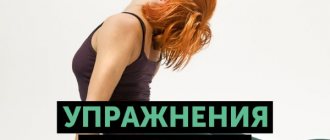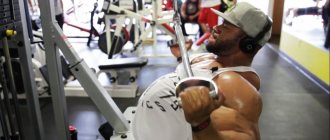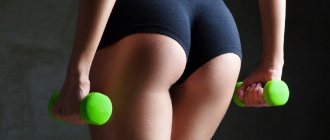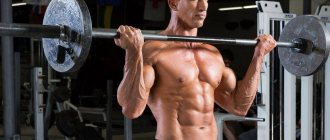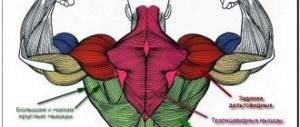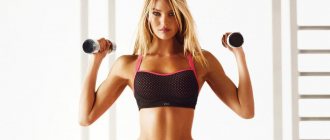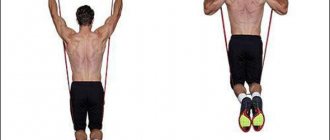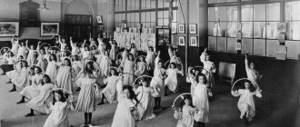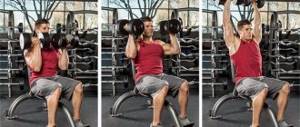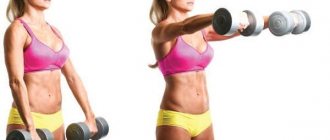Back anatomy
A person is largely made up of muscles. Therefore, it is important to know the anatomy of the back before starting training. The basis of all human skeletal muscles is the back. The whole body rests on the back: hip joints, neck, arms.
The muscles of the body can be layered on top of each other in several layers, therefore the following types are distinguished:
- deep - located closer to the skeleton of the body;
- superficial - removed from the skeleton.
Functional purpose of the spinal muscles
It is generally accepted that the main task of a back corset is to support the body in an upright position. At the same time, they often forget. However, the tasks of the muscle corset are not limited to this. Correct position of the back (posture, stance, neck position), protection of the spine, inside of which the spinal cord is located, from external influences or damage, maintaining the position - all this work, every day, is performed by the muscle corset.
Muscle division into layers
Before you start training, you need to understand the structure of muscles in layers. All of them are divided into external and internal. The external ones are divided into the first layer, the second and the third. Intrinsic muscles consist of deep, middle and superficial layers.
The first layer of extrinsic muscles consists of the trapezius and latissimus muscles in the back. At the base of the second is a diamond-shaped (small and large). The third, more complex layer consists of the serratus muscles of the scapula, infraspinatus, supraspinatus, subscapularis, and teres.
In turn, the internal superficial ones consist mainly of the belt muscles of the neck and head. The middle ones are based on the extensor muscles of the back and the transverse spinalis. The deep muscles consist of the interspinous, intertransverse, lumbar multifidus, suboccipital and levator ribs muscles.
Tips for parents
The need for stretching and muscle training is inherent in nature, which is why preschool children eagerly engage in impromptu fitness - performing various tricks during games and walks.
Parents need to encourage them by creating a safe environment and exercise equipment that helps them burn off their energy.
The participation of adults should consist not only of the absence of a ban on physical activity, but also of coaching support: it is necessary to correctly assess the child’s capabilities and set feasible tasks for him.
A good technique for correcting posture is to align yourself with the wall with the back of your head, shoulder blades, buttocks, legs and heels.
If such a static exercise causes back pain, you need to pay more attention to the child’s physical training. A daily routine with a gymnastic stick will introduce an element of play and allow you to solve the problem in its infancy.
With such a simple attribute, you can perform bends, pull-ups, squats and lunges.
Such a game plot, reminiscent of martial arts classes, can be supplemented by mastering standing at attention, simulating swimming movements in a prone position, crawling on a belly, pulling up on a horizontal bar and other movements for flexibility and strengthening the muscle corset.
Back exercises mastered at an early age will help children adapt to the school period: daily exercise, which has become a habit, will protect the child from the harmful effects of physical inactivity and injuries that await a person at all stages of life.
Therapeutic exercises for back pain
Often a person cannot tolerate back pain (musculoskeletal function is impaired, pain syndrome, sometimes the pain radiates to the internal organs). You can cope with simple diseases when your back hurts with the help of special exercises.
Consult your doctor before attempting any treatment at home. A professional doctor will help you create a set of gymnastic or rehabilitation exercises together with other treatment methods.
Forward bends
The legs are positioned slightly wider than the shoulders, the neck is elongated and the back is straight. Raise your hands up, bend down to touch the floor with your hands. Hold the position for a few seconds, feel your legs and back. Get up. For those who have back pain, the exercise is suitable due to muscle stretching.
Quantity:
10-15 reps.
Exercise kitty
In the all-fours position, the legs and arms are placed next to each other. Then the back arches up (convex, as in the image), down (a depression is formed in the lumbar region). This exercise stretches and strengthens the back corset. With its help, wrestlers strengthen their backs along with flexibility.
Quantity:
10-15 reps.
Child's pose exercise
The legs are gently bent until the pelvis touches the heels, from a kneeling position. After your pelvis touches your heels, you need to spread your knees wide to the sides and tilt your pelvis towards the floor until you feel a stretch in the muscles of your back and pelvis. It is forbidden to lift the buttocks from the heels, but it is allowed to slightly round the neck and back. One approach is performed per day.
Quantity:
5-10 reps.
Spectacular relief
Experts recommend combining exercises to strengthen the muscles of the thoracic region and back in one workout, ensuring an even load on all areas.
Increasing the relief on the back is one of the difficult tasks that can be accomplished with consistent work on the whole body.
Pumping up muscles in this area requires a certain level of physical fitness.
Basic exercises like push-ups and pull-ups can form the basis of targeted workouts, during which tension is intentionally transferred from the legs and arms to the back.
Rows of barbells or dumbbells from a forward bend position and presses in various directions to increase muscle volume are performed with concentration on the area being worked and increasing repetitions to 40 and up to 3 sets per day.
Back strength exercises for girls in the gym
Other muscles of the body are often worked along with the back (legs and arms). This is due to the lack of sufficient time to fully work out the spinal muscles. However, there are effective exercises for training a group of spinal muscles that require little time. You can do this with dumbbells and a barbell. The exercises below will help you figure out how to properly pump your back on the exercise machine.
Deadlift
Straighten your back, relax and lower your shoulders, tighten your abs. Dumbbells in hands, lightly touching hips. Bend your knees slightly, squat down lightly, and push your pelvis back until your upper back is parallel to the floor. It is important to lower and raise the dumbbells along your legs so that the tension on the muscles is correct. To prevent back damage, you should not use dumbbells that are too heavy (it is better to start small and gradually increase the weight). This exercise with dumbbells can be performed at home.
Quantity:
10-15 reps, 3-4 sets.
Bent-over row
The exercise can be performed with dumbbells and a barbell. First tilt your torso forward a little and sit down. We place our feet shoulder-width apart so that the stance is stable. The barbell or dumbbells are taken with a straight grip. Then, they rise as high as possible, while the position of the remaining parts of the body should be rigidly fixed (only the hands work). If you perform this exercise correctly, you can pump up the latissimus dorsi muscles along with the abs and arms.
Quantity:
10 reps, 3-4 sets.
Raising and abducting arms in an inclined position
This exercise applies to training with dumbbells at home or in the gym. Get into the starting position (feet shoulder-width apart, knees bent, lean your body forward). The dumbbells are held in your hands, slightly bent, with a neutral grip. The arms are raised up to a position parallel to the floor, then slowly brought down. The elbow bend is maintained constantly.
Quantity
: 10-15 reps, 3-4 sets.
The exercise is useful because it can be performed at home without dumbbells. You can use plastic water bottles instead. This will allow you to train every day when it is not possible to go to the gym.
When training in the gym, you can ask the trainer for advice by asking the question: How to pump your back with dumbbells at home. Home workouts will help you build better muscles when used in conjunction with exercises at the gym.
It should be remembered that training with a herniated disc or other back diseases is strictly contraindicated. In this case, it is better to consult a specialist doctor. He will conduct the necessary examinations and find the reason why your back hurts.
Warning
Back exercises can be performed at home in the absence of constant pain, numbness of the limbs, dizziness and other symptoms indicating injuries and diseases of the spine.
Gymnastics as a method of physiotherapy is prescribed only after diagnostic and therapeutic measures have been carried out.
If it is not possible to perform the exercise accurately the first time, or acute pain occurs, it is necessary to reduce the amplitude of the movement, perform it with additional support, or replace it with an easier option.
We pump our back at home
We figured out the question: why pump your back. However, the question: how to properly pump your back at home yourself remains open (what exercises will be effective?). There is a lot of material on this topic on the Internet. However, the back (in particular the spine) is a very important and fragile part of the body, so we have collected only the most proven exercises. So, how to properly train your back muscles at home?
Arm rotation from plank position
Stand in a plank position, but instead of elbows, rest on your palms. Spread your legs slightly to the sides, tighten your lower back and abs to a slight tension. The palm is lifted off the floor, then a circular motion is performed.
Using the plank, we work the lower back, mid-back, abs, and latissimus dorsi muscles in the area of the shoulder blades.
Quantity:
10-15 reps, 2-3 sets per arm.
Swimmer exercise
The swimmer exercise helps to strengthen your back muscles at home without additional equipment. Lie on your stomach, stretch your arms out in front of you, palms down. Then lift your face and upper back off the floor. We pump up the upper back by simultaneously lifting the back and legs as high as possible. Quantity:
10-15 reps, 4-5 sets.
Strengthen your back with push-ups
Lying push-ups are the most popular exercise without sports equipment, allowing you to pump up your back muscles at home. Good for strengthening the spine. Works your back and chest at the same time. Often, the trainer advises girls to train their backs with push-ups.
During the exercise, the abdominal muscles tense, which leads to tension in the back. Thus, it works well on the lower back. Also, the latissimus dorsi muscles are worked at home without additional equipment. Back push-ups, like other muscles, can be trained quickly.
Place your palms on the floor, bring your legs together and stretch them back. Bend your elbows and lower yourself until your elbows are bent at a 90-degree angle. Then, straighten your arms. By performing this exercise regularly, you will quickly pump up your back with push-ups.
Quantity:
10-15 reps, 3-4 sets.
Back training[edit | edit code]
Yuzhakov Anton BEST EXERCISES FOR LATISM MUSCLES
The best exercises for the back
Recommendations from Alexander Shchukin
The muscles of the back include, first of all, the latissimus and the trapezius muscles, which assist them in many movements, as well as the teres major, teres minor and infraspinatus muscles. The latissimus dorsi muscles occupy the lower half of the back on the corresponding side. They begin on the lower six thoracic and all lumbar vertebrae, the ilium and the sacrum, and end on the humerus, thereby forming a triangle shape. Functions of the latissimus muscle - turns the humerus inward (pronation), brings the arms to the body, lowers the raised arms (shoulder extension). The main exercises are all types of vertical and horizontal rows, as well as pullovers.
The structure and attachment of the latissimus dorsi muscles does not allow us to emphasize the load on any particular part of them (bottom, top, inner or outer part), as is possible with the same trapezius muscles, where the function of their upper part differs from the function of the lower. Any exercise for the lats works them along their entire length, the only difference is the degree of participation of the synergistic muscles.
Hypertrophy of muscle fibers occurs from one attachment point to another evenly, therefore, as the back muscles grow, they become thicker and wider, regardless of the type of exercise used. The final result will be determined by genetic factors.
And so, theoretically, for maximum hypertrophy of the latissimus muscles, one could limit oneself to one single exercise, but none of the bodybuilders do this. It is psychologically more comfortable to do a variety of exercises, since behind this we see an imaginary variety in development. This is partly true.
Back
- these are not only the broadest, and in some exercises the emphasis on other back muscles can noticeably shift. For example, the main function of the lower trapezius muscle (the so-called mid-back) is to bring the shoulder blades closer to the spine or bring the shoulder blades together. Therefore, the main exercises in which the trapezius will participate with its lower beams are all types of horizontal rows, barbell/dumbbell rows to the belt in an inclined position. The function of the teres major muscle is to internally rotate the shoulder and lower the raised arm (shoulder extension).
Therefore, it is most actively involved in those types of vertical rows where the humerus moves along the body, for example, rows of the upper block with a narrow grip, horizontal rows with a narrow grip, pullovers.
From here we can see that horizontal rows (this can be a block or a lever machine like a Hummer) actively develop the latissimus dorsi, lower trapezius and teres major muscles. Does this mean that we can limit ourselves to one single similar movement in training the back muscles? No!
In the horizontal block row, we simultaneously work many muscles: shoulder flexors (biceps, brachialis and brachioradialis), latissimus, trapezius, teres major, posterior deltoid and erector spinae muscles. That is, the load is dispersed between this entire array. The situation is similar with bent over rows.
At the initial stage of training there would be no need to be afraid of such dispersion, since beginners easily react even to indirect loads. But as the athlete develops, it will become increasingly difficult to create the fatigue in the latissimus muscles necessary for hypertrophy, which is further aggravated by poor technique.
Most often you notice the following errors when performing horizontal and bent-over rows:
- pulling the handle (barbell) to chest level, which shifts the load on the shoulder flexor muscles,
- wide grip rows, which shifts the load to the rear deltoids,
- active work of the muscles that straighten the spine, in order to set inertia to the movement, which leads to the fact that the latissimus works actively only part of the amplitude.
As a result, many people simply do not feel the work of the latissimus muscles in these truly wonderful exercises and the muscles do not receive proper stimulation, despite the presence of general fatigue. To avoid such a development of events, it is necessary not only to be more attentive to the technique, but also to include in the training exercises where the latissimus muscle is guaranteed to work most actively, and the assistant and synergist muscles are smaller. These will be vertical rows or wide grip pull-ups.
With a wide stance, the biceps will not be able to dominate the movement as with a narrow grip, and pulling from top to bottom will completely eliminate the help of the lower back. Variants of vertical rows with a narrow grip (towards you or parallel) are also possible, but this is more suitable for someone who knows how to control the work of the lats and “turn off” their hands. Also, a good way to accentuate the load would be to do pullovers in the simulator.
The simulator is preferable to free weights, as it provides constant tension in all areas of the amplitude. In this case, the biceps and lower back do not participate in the exercise at all, but the long head of the triceps begins to work more actively, since it performs the function of extension and adduction of the shoulder (when the humerus descends along the body)
If we look closely at the training programs of high-level athletes, we will definitely notice a combination of these movements: horizontal rows or bent-over rows plus vertical rows or wide-grip pull-ups. This is certainly justified theoretically and has been confirmed practically.
Now, regarding the load mode. We can observe how athletes practice purely power work on the back with heavy weights in the range of 5-8 repetitions, often accompanied by cheating, as well as more accentuated and technically precise work in the range of 12-15 repetitions. Both are equally useful, especially in combination, as they allow you to work the two main types of muscle fibers that predominate among bodybuilders: glycolytic and intermediate.
In addition, in some exercises you can use a static-dynamic mode that can simultaneously stimulate all three main types of muscle fibers.
Based on the existing canons of bodybuilding, you can create a template on which back training will be built:
- First of all, complex complex movements are performed, secondly more accentuated ones
- First of all, a high-intensity regime (heavy weights) is used, then a lower intensity.
Using exercise machines to train your back
Some people have various back exercise machines at their disposal. With their help, it is possible to organize proper training. In this section of the article you will get the answer to the question: How to properly pump your back on a simulator
so as not to rip it off.
Also, what exercises to do
to get maximum results.
The main rule of any training
Training will be beneficial only if the athlete adheres to the following rules:
- Training should be regular. so that the body gets used to the stress;
- The increase in loads should be gradual (a sharp increase in load will lead to injury);
- Before training, be sure to do a warm-up to warm up your muscles.
It doesn’t matter whether you train your back muscles at home or in the gym under the supervision of a trainer - always remember these rules and follow them.
What equipment to use for training
There is a myth: If you use expensive modern equipment, your training will be effective. For some, a crossbar is enough for training, while others need professional training equipment.
Pull-up exercise on the bar
A universal exercise that is widely popular among men. The exercise is popular due to its versatility. You can use it to pump up your biceps. When you pump your abs, your oblique abdominal muscles become stronger.
To perform this exercise, you need to hang on the bar by your hands. Then bend your elbows until your chin rises above the bar. Thus, on the horizontal bar, the athlete lifts himself using the muscles of the back, arms, shoulders and forearms.
Quantity:
5-10 reps, 3-4 sets.
Training programs[edit | edit code]
Program 1[edit | edit code]
- Bent-over barbell row 3X6-8
- Wide grip vertical block row 3x12-15
Simple and effective program. First of all, a more complex exercise in a strength style is performed, then a more accentuated one with an increased time the muscle is under load. In the first exercise, a little cheating is acceptable, but the second exercise should be performed strictly, without bending the body. The program is recommended at the initial stage, but only after the technique of rowing a barbell to the belt has already been studied.
Rest between sets 2-5 minutes
Program 2[edit | edit code]
- Bent-over barbell row 3X6-8
- Wide grip vertical block row 2x12-15
- Pullover in the simulator in static-dynamic mode 2x 15-20
Advanced version of program 1, here a third exercise has been added - pullover. It must be performed in a static-dynamic mode, that is, without stopping and relaxing the muscles at the beginning and end of the movement, within the amplitude. Them is arbitrary.
Working in the simulator is almost ideal for this mode, as it eliminates the dispersion of the load between the muscles of the assistants and ensures uniform tension throughout the entire amplitude. Performing exercises in three modes will allow you to stimulate hypertrophy in almost all muscle fibers of the latissimus muscle in one workout.
Rest between sets 2-5 minutes
Program 3[edit | edit code]
- Seated horizontal block row 6X6-15 (reverse pyramid)
- Wide grip vertical block row 2x12-15
Rest between sets 2-5 minutes
The first exercise uses the “reverse pyramid” method. That is, in the first approach, a weight is selected with which you can perform 6 repetitions. Then, after a two-minute rest, one tile is removed from the machine and as many repetitions are done as possible until failure. Then rest and again minus one tile. Thus, during the exercise you should do 6 approaches with a gradually increasing number of repetitions.
This will allow you to work out the entire muscle mass of your back in different modes. The second exercise plays the role of “finishing off” the latissimus muscle. This program is quite simple and is suitable, first of all, for those who have lag in the middle of the back, that is, the trapezius muscle.
Program 4[edit | edit code]
- Pull-up on the bar with a wide grip 3x8-12
- Dumbbell row to the belt 3x8-12-15 (reverse pyramid)
Rest between sets 2-5 minutes
Again, a simple program. In the first place this time is a more accentuated movement, although it can only be called accentuated only conditionally. Yes, the lower back does not work here and the biceps are not so active, but there is an opportunity for cheating. It is worth resorting to if you cannot complete the planned number of repetitions.
The dumbbell row to the waist is a good alternative to the bent-over row, but unlike the latter, it eliminates the help of the back and the load on the legs, and also allows you to concentrate on each side of the back separately. It is performed in this program according to the principle of an inverse pyramid. That is, with each approach the weight of the dumbbell decreases.
Program 5[edit | edit code]
Day 1
- Barbell row to the belt 3x6-10
- Horizontal block row while sitting 2x8-10
Day 2
- Wide grip pull-up 2x12-15
- Vertical block row with a narrow parallel grip 2x12-15
This option provides two back workouts per week, so the volume of each of them is slightly reduced.
In the first training session, exercises are performed where the trapezius muscle (middle of the back) is more active and the load mode is quite intense; in the second training session, more load goes to the lats, and the intensity, on the contrary, is reduced.
If it is impossible to perform pull-ups in a given number of repetitions, they can be replaced with a vertical pull-down block with a wide grip (to the chest or behind the head).
During the first training session, the lower back also takes part in the exercises; on the second day, it is not involved in order to avoid excessive stress on the lower back in the weekly cycle. Rest between workouts for at least three days.
Recommended for those who have lagging muscle groups in their back.
Is it possible for a man to pump up his shoulders on his own?
You can train your shoulders in the gym using barbells and exercise machines. However, not everyone can regularly visit the gym, asking questions:
- How often should you train at home?
- What and how best to pump up your back muscles?
- Is it possible to combine training of other muscle groups with the back in one day?
How many times a week do you train?
How many times a week you need to pump your back is up to everyone to determine for themselves. If you train your back in the gym, the optimal frequency is 2-3 times a week. This frequency of training is due to the fact that back training in the gym takes place under additional loads (back training with kettlebells and other exercise equipment). The men's gym has a lot of additional equipment.
Back training at home is usually done in a more gentle manner. The most common stretching exercises performed are back exercises and push-ups. Sometimes, at home they train their back with a barbell. Therefore, you can do workouts at home a little more often than in the gym (3-4 times a week).
What to pump your back with?
For greater benefits from training, back exercises are often alternated with other muscle groups. For example, you can train a wide back with your legs or arms. Sometimes they combine the back and shoulders in one workout. If you have a barbell or crossbar, such training is easy to organize. However, the question: what to pump your back with remains open.
When choosing a barbell for home, pay attention to the thickness of the bar. It should be such that you can completely wrap your arms around it. Then back training with a barbell will be enjoyable. It will be pleasant to play sports.
When combining your back and shoulders in one workout, you need to remember that most back exercises simultaneously work your shoulders. Especially exercises on the simulator. You can find a lot of equipment in the gym for girls and men. Therefore, everyone can choose what to pump their muscles with.
Help with back pain
Popular physiotherapist Bubnovsky has developed exercises that can relieve back pain.
They can be used independently in the first stages of discomfort that arises from sitting for a long time in one position, or as a result of awkward movements and training with inadequate load.
Crawling on all fours with alternate stretching of straightened arms in front of you: in the forward direction, first the left hand moves while lowering the chest to the bent knee, then a mirror repetition occurs. The effect is felt after 15-20 minutes.
Lying on your back with your knees bent, hands clasped at the back of your head, do gentle lifts of the chest part of your body, bringing your elbows inward. After 6-8 repetitions, move on to cross swings, in the direction of the knee to the elbow.
Do push-ups from your knees, while the bend angle of your arms at the extreme point should be at least 90 degrees. When performing, look forward.
